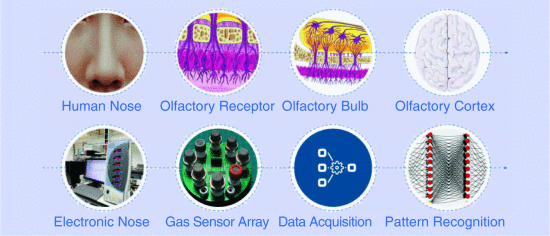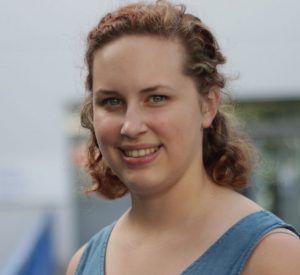
Of the five “traditional” exteroceptive senses — sight (vision), hearing (audition), taste (gustation), touch (somatosensation), and smell (olfaction) — olfaction has one of lowest “data rates,” but is (arguably) the least understood and least well-developed in terms of automation. Robotic vision would seem to be much further advanced than robotic olfaction. Additionally, this comparison is just in relation to human olfactory performance. A dog’s sense of smell overpowers human capability by a factor of 10 000 to 10 0000 (dogs having 50 times more olfactory sensors than humans). For this reason, detection (or “sniffer”) dogs are extensively used in search and rescue, or to search for illicit substances, while healthcare applications include Diabetes Assist Dogs which are trained to monitor smells in the air for a specific scent on the human breath that is related to rapidly dropping or low blood sugar levels, and to “alert” the person with diabetes. Critically, the dog is detecting a change in the volatile organic compound (VOC) information. This information is carried by the chemicals that are naturally emitted by all humans through exhalation, cutaneous respiration (skin gas exchange), or perspiration.
Given the current lack of regulation, there is nothing in principle to stop unscrupulous organizations from deploying surreptitious robotic olfaction.
Modern robotic olfaction technology had its beginnings with the invention of the first gas multisensor array in 1982 [1]. Inspired by mammalian olfaction systems, robotic olfaction typically consists of a multisensor array, which acts as the olfactory receptors, a data acquisition system, which acts as the olfactory bulb and nerves, and a pattern recognition system which acts as the “brain” that processes the signal (see Figure 1). These devices allow the identification of a mixture of chemical compounds, emitted from samples, as a whole without having to identify them individually first. A cross-reactive sensor array is chosen to respond to a wide range of chemical classes so that it can be used to identify odors that may comprise hundreds of individual chemical components. Instead of looking at the individual sensor signal, the combined signal from the sensor array produces a distinct digital response pattern which has been called a “smell-print” [3]. The identification and classification of the odor is accomplished through recognition of this unique smell-print pattern. This allows the system to identify a complex odor without having to separate it into its chemical compounds prior to, or during, the analysis. A pattern recognition system will then try to compare the pattern of the signal with a pattern that has been learned through the training process. This allows for faster and simpler analysis.
Being both noninvasive and low cost, these robotic olfaction systems may radically change medical diagnosis. The technology has the capability to accurately detect diseases before a patient becomes symptomatic, potentially saving thousands of lives and increasing patient quality of care, and life in many instances. There is already evidence of this kind of success.
For example, pancreatic cancer is among the deadliest cancers around the world, and there is no reliable early screening. The prognosis for those eventually diagnosed is often grave. However, it has been shown that not only can pancreatic cancer be diagnosed from urine, but even the stage of cancer can be diagnosed using robotic olfaction [4]. Using similar technology, irritable bowel disease can also be reliably diagnosed [5]. This condition has remained difficult to accurately diagnose until now because the symptoms associated are similar to many other gastrointestinal diseases. With accurate diagnoses in both cases, patients are able to get the correct treatment faster, leading to increased quality of care and higher survival rates.
Robotic olfaction systems can also be miniaturized and made relatively low-cost. Decreased response time and reduced cost per sample offer distinct advantages over traditional laboratory testing, and it is possible to imagine the mass production of commercial at-home testing kits in the future. However, it is evident that the doctor’s role in the diagnosis process needs to be supported by the technology, rather than replaced. While early detection may be made possible, the doctor will be responsible for then accommodating the higher rate of data coming in from these at-home tests (no doubt of varying reliability). Doctors will need to be better supported, with training required on both the analysis techniques in order to interpret results, and (perhaps) the need to explain sensitively the testing procedure and results to patients (the phrase “you smell bad” has scope for normative and cultural misinterpretation), and given tools to triage diagnoses if necessary. Otherwise, the potential of robotic olfaction cannot be realized.
As with many other recent technological developments, such as drones, the potential miniaturization and relative low cost of production of robotic olfaction makes it an attractive business opportunity. Recently, the EU Horizon 2020 project, SniffPhone, has begun developing a SmartPhone plug-in device that could potentially diagnose diseases from exhaled breath [6]. The wide deployment of diagnostic technology may have beneficial ramifications on early diagnosis rates, as discussed. But what comes next? How will the massive amounts of data generated from automated disease detection play into patient care?
Wide deployment in particular raises the possibility of constant monitoring: for example, it has been suggested that the use of smell analytics could make cities “safer and more efficient” [7]. Furthermore, it is not just the diagnosis of unhealthy individuals that may be achieved with screening, it is also possible to apply the technology to healthy individuals. A possible application is to use robotic olfaction for access control: either for access to restricted or secure areas or to operate heavy machinery.
Already some companies have spent enormous sums of money on technologies to track and monitor their employees [8], [9]. Robotic olfaction could also be used as a pre-screening measure to survey job candidates and extrapolate their likely efficiency and future output inferred from their current state of health. For example, suppose that a company installed a robotic olfaction device embedded into a doorframe. Then, after being called for interview, when each candidate (for a position or a promotion) passes through the door frame, an inaudible vacuum sniffs a small sample of air around the candidate, collecting the VOC emission. With this unique identifier, the company could learn and use this biometric information (surreptitiously gathered) to inform their decision-making, without the candidates knowing what criteria were being used in the selection process.
If these measures seem extreme, recall that many companies already adopt and enforce anti-drug use screening policies which require invasive urine/hair/saliva samples that employees and prospective employees “consent” to provide. Given the involuntary form of emission, the surreptitious form of collection and detection, and the current lack of regulations, there is nothing in principle to stop unscrupulous organizations from deploying such devices.
If these measures seem unlikely, consider that it has been demonstrated (as above) that it is possible to electronically reproduce the performance of the human nose. It would therefore be plausible to assert that this is not the limit of technological capability. Indeed, this is the central premise of “scents-on-a-chip” [10], which envisions a miniaturized (nano-scale) device in a future society, that would be disguised in smart sensory clothing or as jewelry but doubles as an olfactory sensing device. This device would be capable of “sniffing” out the surrounding atmosphere but also of spraying timed/controlled mood-altering fragrances.
Therefore, there is no reason to suppose that robotic olfaction could not match, or even transcend, the fine-tuned functionality of the canine nose. Then suppose that, just as with other human characteristics, which allow unique identification (e.g., by fingerprint, iris or gait recognition, or by DNA), it is possible to identify a person uniquely by their VOC pattern [11] — call this a VOCI (VOC identity). This could have some potentially beneficial (and fairly standard) applications: for example, a “VOC-key,” which could be used for access control; and some potentially privacy-intruding applications — enabling what we are here calling odorveillance, i.e., the tracking, monitoring, and identification of behavior and passage through the use of robotic olfaction (cf., [12]–[13][14].
In many ways, odorveillance is no different from other forms of biometric identification, with the attendant advantages and disadvantages [15]. However, perhaps the critical difference between odorveillance and these other forms of identification, and between odorveillance and other forms of — veillance (surveillance for example), is threefold. Firstly, these other forms of identification require the target to present themselves (indeed be present) for identification; odorveillance would not only expose who a target is, but where a target has been (even in that past location’s absence). Secondly, odorveillance relies on the detection of involuntary excretion of VOC, or exhalation (so the only way to prevent -veillance would be to stop breathing, which would be kind of counter-productive in the short term). Wearing a filter would be obvious and, especially in this suspicious age, would expose oneself to the depressing accusation of “something to hide.” Finally, the notion of consent is being completely bypassed: as mentioned above, there are examples of schoolchildren having to supply hair samples to local authorities, and workers having to supply urine samples to employers. But at least here the “consent,” such as it is, is at least informed: there is no such corresponding property of “informed consent” in odorveillance.
Given the potentials of robotic olfaction technologies, we can expect that a range of olfaction devices will eventually enter the consumer market and become part of our everyday life. These devices could enable personal identification or support self-assessment and self-management of an individual’s health and well-being. Yet, a number of questions are immediately raised regarding the rights to privacy: as mentioned previously, how to stop employers from using a veneer of “occupational health surveillance” [16] for “sniffing” their job applicants or existing employees, to identify health problems or monitor employee activities and movements? In addition, what is the balance between improved public health and protection of individuals from public exposure if odorveillance were to be adopted as part of global disease surveillance [17]? Would it be possible to stop fraudulent parties from performing identity theft if VOCI becomes one of the standard methods of identifying an individual? How is it possible to guarantee that these new advance technologies provide full benefits without violating basic human rights and making individuals more vulnerable? These are all perhaps timeless, but nevertheless pertinent questions, but with their own twist, and need to be considered before the technology becomes commonplace.
Wider implications for privacy and personal security of individuals need to be considered to ensure responsible design and ethical application of robotic olfaction devices and to prevent unauthorized data collection, sharing, and use. As with “standard” types of — veillance and digital data sharing, odorveillance and olfaction technologies will need governmental control and legally enforceable regulations to protect society from catastrophic data misuse and potentially even oppression. Regulations should be put in place to restrict the use of diagnostic olfaction technologies to medical institutions or, if made available for public consumption, olfaction devices could be encoded to each individual service user limiting data collection capabilities. VOCI will require a consistent high level of protection under sensitive personal data regulations and a “VOC-key” would need to be combined with other biometric data to form a secure “identity-key.”
In conclusion, the significant technological advances in robotic olfaction, together with the rapid rate of progress, the scale of achievement, and the range of medical and commercial applications, suggest that this will become an area of increased interest and research activity in the next 5–10 years. Therefore the time is coming, if left unchecked, that people may not be in control of when or where they are being tracked, by whom and doing what, directly from their characteristic “odorprint.” Is this sort of odorveillance really what we want?
Author Information
Emily Stark is a graduate student researcher and Stephen Hoover an undergraduate student in the Machine Perception and Cognitive Robotics Laboratory, Florida Atlantic University, Boca Raton, FL 33431. Email: estark2017@fau.edu.
Jeremy V. Pitt is Professor of Intelligent and Self Organizing Systems, and Kristina Milanovic is a Postgraduate Researcher, in the Department of Electrical and Electronic Engineering, Intelligent Systems and Networks Group, Imperial College London, South Kensington London SW7 2AZ, U.K.
Alfian Nur Wicaksono is a Ph.D. student in the Biomedical Sensor Laboratory, School of Engineering, University of Warwick, Coventry CV4 7AL, U.K. Email: a.wicaksono@warwick.ac.uk.
Victoria Lush is a Research Fellow at Aston University, Birmingham B4 7ET, U.K. Email: v.lush1@aston.ac.uk.

Emily Stark

Jeremy Pitt

Alfian Nur Wicaksono

Kristina Milanovic

Victoria Lush

Stephen Hoover
To access this full article, including references, click HERE.







 JOIN SSIT
JOIN SSIT